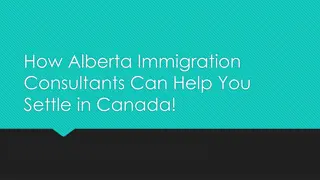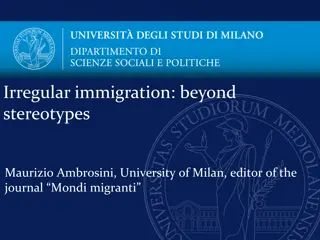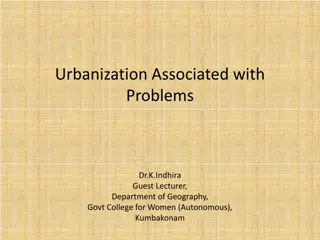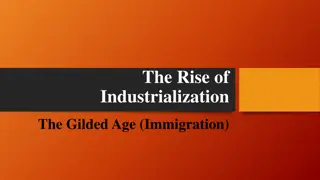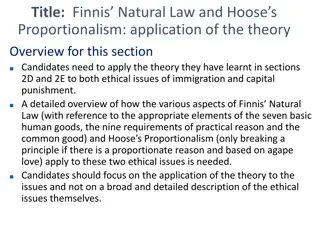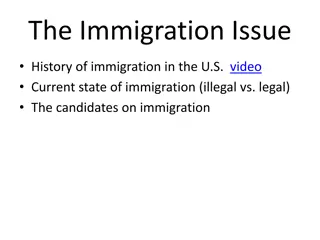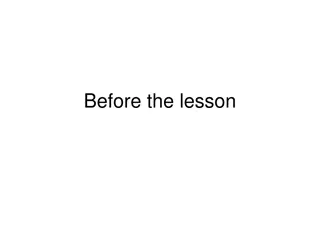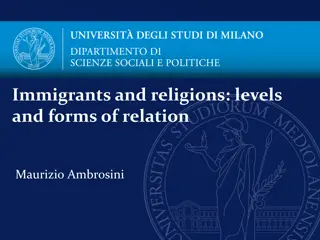Immigrants and Immigration in Canada: The Essentials
This condensed version covers key aspects of immigrants and immigration in Canada, highlighting the country's need for immigrants due to declining birth rates and aging population. It discusses paradoxes, fertility rates, and societal views towards immigration.
Download Presentation

Please find below an Image/Link to download the presentation.
The content on the website is provided AS IS for your information and personal use only. It may not be sold, licensed, or shared on other websites without obtaining consent from the author.If you encounter any issues during the download, it is possible that the publisher has removed the file from their server.
You are allowed to download the files provided on this website for personal or commercial use, subject to the condition that they are used lawfully. All files are the property of their respective owners.
The content on the website is provided AS IS for your information and personal use only. It may not be sold, licensed, or shared on other websites without obtaining consent from the author.
E N D
Presentation Transcript
Immigrants and Immigration in Canada The Condensed Version
Paradox: Canada needs immigration more than immigrants need Canada [?]
Why Canada needs Immigrants Offset the declining birth rate Ensure a sufficient tax base Expand the size of the domestic market To strengthen Canada s global economy Stimulate sustained economic activity through production and consumption
Canadas Declining Fertility Rate 1985 - Annual Report to Parliament on Future Immigration Levels: Canada s fertility rate has fallen below replacement levels (2.1 children per woman) Prompts a change in policy that looks toward immigration for the future of population and economic growth 1971: 2.13* 2009: 1.67 2010: 1.63 2011: 1.61 2012: 1.61 2013: 1.59 *The last time Canada s fertility rate was above replacement level
Fertility Rate in Canada - Trends Canada needs immigrants to replace its aging population and workforce
Paradoxes of Immigration Canada relies on temporary foreign workers to address short-term labour needs at the expensive of Canada s long-term interests In a 2010 survey, 81.4% of Canadians agreed (65.3%) or somewhat agreed (16.1%) that: Immigration reflects a positive feature about Canada Immigration strengthens economy The government should do more through language/labour market support to assist immigration settlement Immigrants do a good job of fitting into Canada On the other hand, there are some double standards exhibited: Immigrants steal jobs from real Canadians Unemployed immigrants are freeloading parasites Canadians are willing to support immigration as a policy, but unwilling to support the integration of immigrants as practice
Canada as an Immigrant Society Facts and Figures An immigration society is one that takes a principled and proactive approach to immigration based on four criteria: Policies and principles regulate the entry of immigrants Programs are in place facilitate the integration and settlement of immigrants Immigrants are entitled to all rights, including permanent residency and citizenship Immigration and immigrants are viewed as an asset for society-building Canada is the destination of choice for international immigrants More than half the people (53%) from the world s 24 leading economics say that move to Canada if they could: 77% of Chinese, 71% of Mexicans, 68% of Indians, 64% of Turks, 62% of Polish/South Africans However, Canadians remain conflicted over the pros and cons of immigration In principle (and sometimes by policy), Canada endorses these attributes, but this is not necessarily translated into practice.
The Three Pillars of Immigration Economic Class (a) Entrepreneurial Program (i) Self-employed, (ii) Start up Visa (b) Provincial Nominee Program (c) Canadian Experience Class (1) International Students Program, (ii) Temporary Foreign Workers Program Family Class (a) Family Sponsorships (See Attached) (b) Independent Immigrant Applications *(Includes Assisted Relatives/ Selected Workers = Technically Economic Class) Humanitarian Class (a) refugees (persecuted on the basis of (i) political association, (ii) membership in a social group, (iii) religious affiliation, (iv) nationality, or (v) race). (b) Persons Eligible Under Special Humanitarian Measures. __________________________________________________________________________________________ Temporary Residents (a) Work Visa (b) Student (c) Visitors (d) *Live-in Caregivers (i) Home Child Care Provider Pilot , (ii) Home Support Worker Pilot {medical needs}
Family Class Immigration Family Class: - Family reunification to improve integration Two entry strategies: 1. Migrate as a unit 2. Sponsoring family members Processing times vary (6 months - 30 months, + years) Some family ties are tested through DNA testing (especially for those from Africa, the Caribbean, India and Pakistan)
Economic Class Immigration Three programs: 1. Entrepreneurial Program (businesses, investors) 2. Provincial Nominee Program - aimed to meet specific labour needs in certain provinces 3. Canadian Experience Class - creates designer immigrants - targeted to international students and temporary workers - values high end work vs. lower skill levels
Humanitarian Class Immigration Refugees and Protected Persons Class: Humanitarian and legal obligations Three categories of refugees: 1. Sponsored Refugees (government, private, individual, clubs, church groups) 2. Refugee Claimants (claim refugee status upon arrival spontaneous arrivals ) 3. Rejected Refugee Claimants (protected under the Pre-Removal Risk Assessment)










